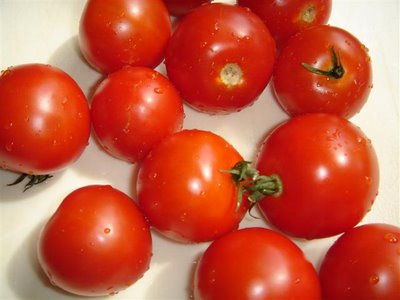
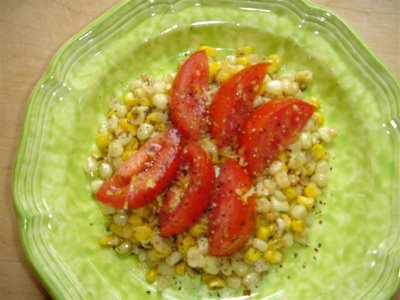
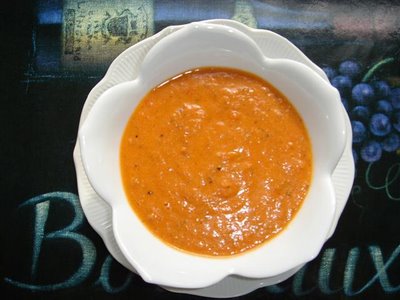
Food for thought; food for the soul; food for the mind, but primarily food to eat.



A few tips, a little self-confidence, some fresh ingredients and we're easily on our way to a good meal.
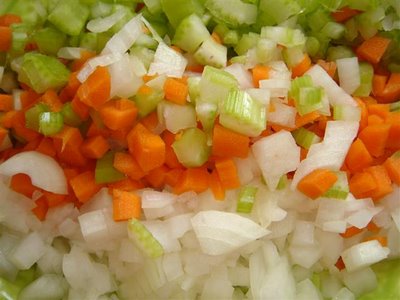 Mirepoix
Mirepoix
Mirepoix, pictured above, consists of diced onions, carrots and celery, a combination of vegetables commonly referred to as aromatics, used as the flavor base for a wide variety of dishes, soups, stews, sauces. If the dish has a Cajun or Creole flair, the carrots are replaced by green peppers and the combination is known as the Holy Trinity. Many Spanish dishes call for a Sofrito base which is garlic, onions and tomatoes. The addition of roasted peppers to the garlic onions and tomatoes gives the sofrito a Caribbean or Latin American flair. Italian dishes are given a flavor kick and a boost of nutrition by adding garlic to the basic mirepoix mix and is then called soffritto. Easy to see that with a little twist, you can quickly become an accomplished continental cook.
The traditional mirepoix ratio is 2:1:1 of onions, celery, carrots. But these veggies are very forgiving and an exact count just isn't necessary to achieve a rich, delicious base for everything from bean soup, to marinara sauce, to slow roasted pork, pot roast or beef stew, just to name some comfort foods that we all occasionally crave. The addition of aromatics, spices and/or herbs, provide depth of flavor and enriched nutrients to simple dishes and invariably generate compliments to the cook.
I often hear people refer to 'doctoring up' some bottled spaghetti sauce. By quickly dicing onions, carrots, celery and with a whiz of the can opener, you can have a pot of marinara sauce simmering away in record time. I often cook a batch of Italian sausage and peppers when I make a pot of sauce. I like to use traditional mirapoix for the sauce, the carrots enrich the flavor tremendously by imparting a sweetness to offset any bitterness from the tomatoes. But with the sausages, I use bell peppers (red and green), onion and minced garlic. Instead of a small dice, I cut wedges of onion and chop the peppers in approximately two inch pieces.

Marinara simmers, sofrito sauté and par-boiled sausages await their turn.
Prepping and cooking both dishes took about an hour. I'd suggest you allow a little longer as I've been making these things for years and may have a slight edge on the prep work. Look at all the meal possibilities I have on hand this week.Perhaps cheese ravioli, using the convenience of frozen Celantanos, with the marinara sauce or some other pasta with sausage and sauce. How about a great sausage and pepper sandwich on a hoagie roll with mozzarella cheese? Wrap in foil, place in a 350 degree oven for 15 minutes. Some of the sauce can be used to make chicken or eggplant Parmesan later in the week. I can freeze half of the sauce for use down the road -- same with the sausage and peppers. Cook once; eat often!
Next time you think about 'doctoring' some bottled spaghetti sauce, give quick marinara sauce a whirl. Here's the recipe for all those who like things spelled out!
Marinara Sauce
Just like Noah's Ark - Two of Each
2 onions, diced; 2 celery stalks, diced; 2 carrots, peeled and diced; 2 cans (28 oz)diced tomatoes (Muir Glen organic are best); 2 bay leaves; salt and pepper
Heat 1/2 cup of EVOO over medium heat, sauté onions and garlic until translucent then add celery and carrots, 1/2 tsp salt and some freshly ground pepper. Sauté until soft then add tomatoes and bay leaves. Simmer uncovered over low heat until sauce thickens. Approximately 45 - 60 minutes. Remove from heat, discard bay leaves, puree with immersion blender or regular blender. Taste for salt and pepper.
**********************************************
Book Nook
I'm playing around with a separate book blog...keep posted. Meanwhile, I did read a couple of good ones this week.
No Good Deeds - Laura Lippman
Black Dog - Stephen Booth
"The man who doesn't read good books has no advantage over the man who can't read them."
- Mark Twain
'Till next time . . . keep on cooking!
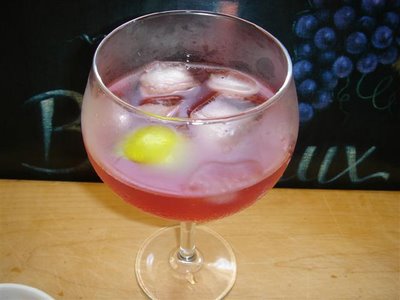
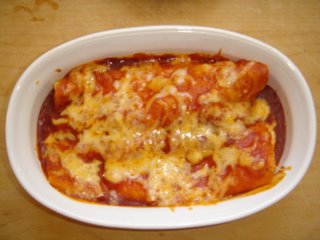

 Potato - Leek Soup
Potato - Leek Soup
Scrub the potatoes, peel and cut into one inch chunks. Place them in a saucepan with the leeks, celery, carrot and butter. Add the salt. Cook the vegetables, stirring over medium heat until the butter is melted and all pieces are coated.
Add the water, bring to a boil, cover and reduce heat to a simmer. Cook until the potatoes are soft (20 - 30 minutes) Check the moisture level and add more water if needed.
When the potatoes are tender, remove the pan from the heat and either puree the entire contents in a blender or food processor or as I've done, puree half. (I like the soup chunky). Return the soup to the saucepan, add the evaporated milk and freshly ground pepper. Taste for salt. Heat the soup gently, until just hot. Try not to let it boil.
After picking up the leeks, I found a pint of grape tomatoes for .99 and a quart /pound of strawberries for .99.
While the soup was simmering, I slipped the tomatoes, which I'd washed and sliced in half, onto a foil lined cookie sheet, sprayed them with a light misting of olive oil and sprinkled on a pinch of kosher salt, and then put them into a 275 degree oven to roast off. An hour or so later these luscious little oven dried tomatoes were ready. Once cooled, I stored them in the fridge in a covered container with a little olive oil to patiently wait to be the star of an easy pasta dish.
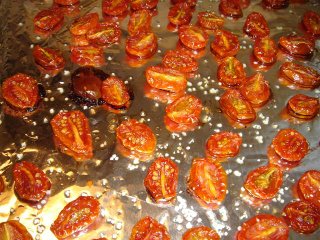 Oven Roasted Grape Tomatoes
Oven Roasted Grape Tomatoes
Angel Hair Pasta w/ Roasted Tomatoes
Add a couple of minced garlic cloves to 1/4 cup of extra virgin olive oil. Saute with a dash of cracked red pepper flakes. Mince 8 pitted Calamata olives add to saute pan with oven dried tomatoes. Toss with angel hair pasta and a little pasta water. Top with pan roasted pine nuts and fresh basil. Fast, easy and good!
A few weeks ago, Amanda Hesser had an intriguing article and recipe in the New York Times for fresh strawberry sorbet made with lemon courtesy of those marvelous chefs, Ruth Rogers and Rose Gray of the River Cafe in London. You know, the ones who brought us that wonderful pork chop with lemon roasting technique.
Fortunately, the cylinder for my ice cream maker was tucked into the freezer ready to go, but unfortuntely, the veggie bin held many limes but nary a lemon. One of the great things about cooking is the fun and challenge of improvising . Without hesitation, I exchanged a lime for the lemon and proceeded to process this refreshing dessert.
Strawberry / Lime Sorbet
1 cup of sugar
1 pound strawberries, hulled
Juice of 1 lemon or lime
Place the chopped lemon or lime and sugar in the food processor, pulse until combined. Puree the strawberries along with the citrus juice of choice. Add to the chopped citrus/sugar mix, taste and add more juice as desired. The citrus flavor should be intense but shouldn't overpower the strawberries. Pour the mixture into an ice cream machine and process until frozen. I like to add a tablespoon of vodka at the end to keep the sorbet scoopable.
So there we have three great dishes. Easy to prepare and about as economical as you can get, short of eating plain beans!
'Till next time. . . keep on cooking!
Fried meat-filled pastries, known as meat patties in Jamaica and empanandas on the Spanish islands, are popular snacks. The heritage undoubtedly stems from the Cornish pasties of Britain, but the chili-laced filling is pure African-Caribbean.
 Jamaican Meat Patties
Jamaican Meat Patties
In the mid-80's, one of my favorite lunch spots was a little place in College Park called, Aunt Eva's Patty Palace. Eva made the most delicious Jamaican meat patties, both mild and spicy. I always opted for the spicy hot ones. The ground meat and spices were liberally laced with fiery, minced chilis and the pastry wrap was rich, flaky and fried.
My patties are good, but they don't hold a candle to Aunt Eva's. The meat I use is probably too lean, no lard in the pastry and I bake them instead of frying them and she had her own secret spice combination. Nevertheless, homemade patties still beat the frozen supermarket version. They're a great treat to zip from the freezer into the oven when my mouth cries for a spicy bite. The patties make a fast lunch with a bowl of soup or a little salad. And they're especially good as an hors d'oeuvre with a cold beer, a chilled Chardonnay or better yet, a tall, cool Planter's Punch made with native Jamaican rum.
Several years ago, my neighbor, Ann, surprised me with a kitchen gadget called "The Pocket Gourmet". Ann said when she saw it, she just knew it was something I'd find a good use for. . .and she was right. Billed as the "ultimate kitchen tool", though I wouldn't go that far, it has made patty-making a much easier task. I use the larger one for luncheon patties and the smaller one for appetizer size.
 The Pocket Gourmet
The Pocket Gourmet
I think making Jamaican patties is worth the effort, particularly if you break up the task into two sessions. Cook the meat filling and make the pastry dough one day, then refrigerate both. The following day, form the patties, freeze them individually on a lined cookie sheet, then wrap them in batches in freezer paper and slip into a zip lock bag for storage. Or you can bake off the whole batch and then freeze them and reheat as you use them. I've done both and prefer the freshly baked version as opposed to reheated. The following quantity of ingredients makes about three dozen small patties.
Jamaican Meat Patty Filling
1 1/2 lbs ground beef or pork or combination
2 TBS annatto oil or vegetable oil
4 green onions, including tops, finely chopped
1 yellow onion, chopped
1 fresh green or red chile, minced (more for spicy)
2 garlic cloves, minced
1 tsp paprika
1/2 tsp dried thyme, crushed
1/4 tsp ground allspice
dash of ground cloves
1 cup canned tomato sauce
salt and pepper to taste.
In a nonstick skillet over high heat, brown the meat until crumbly. Remove the meat to a bowl with a slotted spoon and discard any fat remaining in the skillet. In the same skillet over medium heat, warm the oil then add the green and yellow onions and the chile. Saute until softened, about 3 - 4 minutes. Stir in the garlic, paprika, thyme, allspice and cloves and saute for another 30 seconds, then stir in the tomato sauce and return the meat to the skillet. Reduce the heat to low and season with salt and pepper to taste. Continue cooking over low heat for about 20 minutes to let the flavors blend. The filling should be fairly firm. If too loose and wet, stir in a couple of tablespoons of bread crumbs.
Pastry for Meat Patties
3 cups unbleached all purpose flour
1/2 tsp salt
1/2 tsp baking powder
1/2 tsp turmeric
2/3 cup shortening
2/3 cup cold water
In a mixing bowl, combine the flour, salt, baking powder and turmeric. Using a pastry blender or fork, cut in the shortening until the mixture resembles coarse meal. Stir in the water and using a fork or fingers, mix to form a ball.
Take walnut sized pieces of dough and roll them out on a lightly floured board to make 4" circles. Place a couple of tablespoons of the filling in the center of each circle. Fold the pastry in half and pinch to seal the edges with the tines of a fork.
To Bake: Preheat oven to 400 degrees. Place pastries on an ungreased baking sheet and bake until golden brown, 25 - 30 minutes. Serve hot or at room temperature. I like to drizzle them with three pepper lemon sauce as I eat them for an even greater heat punch!

Slow Roasted Pork Taco
It's not just that Burger King signature burger that takes two hands, lots of great food is best eaten without benefit of knife and fork. Easily swayed by suggestions from one of my favorite food writers, Mark Bittman, this was the weekend for slow roasted pork to enjoy as tacos, burritos and enchiladas. All but the latter easily eaten with two hands. The enchiladas do require a utensil as that molten melted cheese can get messy.
Over ten years ago, I fell in love with the adventuresome Latin American and Spanish cooking techniques that Mary Sue Milliken and Susan Feniger introduced to me with their TV cooking show, Cooking with Too Hot Tamales. Their book by the same name quickly made its way into my food library and I began to experiment using their recipes and tips as a springboard for some mighty fine eats.
One of my favorites was a take on traditional pibil cooking from Mexico's Yucatan Peninsula. Pork (conchinita) is marinated in a blend of achiote paste, citrus juices and spices before being wrapped in banana leaves and cooked in a banana leaf-lined pit called a pibe. Several years ago, Greg took me to Border Grill in Santa Monica for dinner. Without hesitation, I ordered the Conchinitas Pibil. Just had to see if I'd come close - can you imagine my surprise when halfway through the meal, Mary Sue Milliken appeared at the table to ask if everything was okay. When I explained that I'd been attempting the conchinitas pibil at home, she asked if hers was as good as mine?
The recipe in last week's New York Times for slow roasted pork is an easy variation of this specialty. I picked up two pounds of boneless pork spareribs, marinated them with garlic, citrus and toasted spices, made a makeshift banana leaf wrap with aluminum foil and roasted them off in a 300 degree oven for a little over 3 hours. When checked, the meat was tender and lusciously fragrant.
If your experience with tacos is limited to ground meat flavored with tomato sauce and an envelope of mystery spices served in a hard shell, you might want to refer to Mark's easy instructions, Taco Technique, Bottom to Top, to learn how to build a mouth-watering treat. Mine always need two hands.
While the pork is slow roasting there's plenty of time to make some fresh salsa. If you must use the bottled stuff at least buy one with a minimum of ingredients and let those be not only things you recognize as edible but organic. Here's an easy hot, red salsa that will complement the pork and give your taste buds a little jolt!

Red Salsa Components
2 cups diced tomatoes
1/4 cup minced jalapeno or serrano pepper (more depending on your tolerance for heat)
1/3 cup diced onion (put in a strainer and rinse under cold water)
1/3 cup coarsely chopped fresh cilantro
1/2 tsp salt


Tilapia with Jerk Seasoning
This quick meal for one is easily multiplied to fit your needs. I've used one tilapia filet but any mild white fish will work equally well. Notice it's in two pieces. Invariably tilapia filets are thicker on one side. By cutting the filet in half, the smaller side can be removed from the pan sooner than the thicker side, preventing it from being overcooked and dried out. The filets are dusted with a delicious Jamaican style BBQ blend of jerk seasoning for chicken and fish from Penzeys Spices and slipped into a little hot olive oil along with a wedge of lemon. The lemon is not squeezed at this point, it just rests in the pan allowing the heat to carmelize it. When the filets are plated, the warm juice from the wedge is squeezed onto the fish using a pair of tongs. Two minutes cooking on each side was all that was needed for this little filet. Some romaine hearts with sliced red onion and diced tomato drizzled with olive oil and lemon juice made a simple salad and I heated up a serving of frozen petite peas with a handful of frozen shoe peg corn (cooked together). Once the salad greens were washed and spun dry, the onion sliced, the tomato diced, and the veggies were at the boil, I put the fish in the pan, dressed the salad and within 15 minutes from start to finish, I was pouring a glass of wine to accompany this fine plate of food. Talk about fast food ! This is simple, wholesome, economical and mighty good!
.jpg)